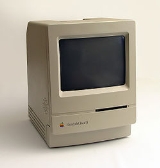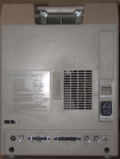
Macintosh Classic II
Encyclopedia
The Apple Macintosh Classic II (also known as the Performa 200) replaced the Macintosh SE/30
in the compact Macintosh
line in 1991. Like the SE/30, the Classic II was powered by a 16 MHz Motorola 68030
CPU and 40 or 80 MB
hard disk
, but in contrast to its predecessor, it was limited by a 16-bit
data bus (the SE/30 had a 32-bit data bus) and a 10 MB
memory ceiling.
While the Classic II shares a case with the earlier Classic
, architecturally it is more similar to the Macintosh LC
. The use of custom IC
s, identical to those used in the LC, enabled the Classic II to have a lower component count than older Macs. Unlike the LC and the SE/30 before it, the Classic II did not have an internal PDS expansion slot, making it the first slotless desktop Macintosh since the Macintosh Plus
.
There were two Classic II cases. Later models came with a new speaker grille on the left side for enhanced sound (as pictured).
The Classic II was the last black-and-white compact Macintosh. It was also the last desktop Macintosh to include an external floppy disk
port. Apple discontinued support for the Classic II on January 1, 2001.

†The Classic II has a 50-pin internal expansion slot intended for either an FPU
co-processor or additional ROM
. The socket is not designed to be used for any other purpose and is not suitable for use as a general expansion slot. Apple never produced an expansion card of any kind for this slot, although at least one third-party FPU was available: the FastMath Classic II by Applied Engineering.
Macintosh SE/30
The Macintosh SE/30 is a personal computer that was designed, manufactured and sold by Apple Computer, Inc. from 1989 until 1991. It was the fastest and most expandable of the original black-and-white compact Macintosh series....
in the compact Macintosh
Compact Macintosh
"Compact Macintosh" or "Classic Macintosh" are informal terms that refer to the direct descendants of the original Macintosh personal computer case design by Apple Computer, Inc. All of them are all-in-one desktop computer designs with the display integrated in the computer case, but not the...
line in 1991. Like the SE/30, the Classic II was powered by a 16 MHz Motorola 68030
Motorola 68030
The Motorola 68030 is a 32-bit microprocessor in Motorola's 68000 family. It was released in 1987. The 68030 was the successor to the Motorola 68020, and was followed by the Motorola 68040. In keeping with general Motorola naming, this CPU is often referred to as the 030 .The 68030 features on-chip...
CPU and 40 or 80 MB
Megabyte
The megabyte is a multiple of the unit byte for digital information storage or transmission with two different values depending on context: bytes generally for computer memory; and one million bytes generally for computer storage. The IEEE Standards Board has decided that "Mega will mean 1 000...
hard disk
Hard disk
A hard disk drive is a non-volatile, random access digital magnetic data storage device. It features rotating rigid platters on a motor-driven spindle within a protective enclosure. Data is magnetically read from and written to the platter by read/write heads that float on a film of air above the...
, but in contrast to its predecessor, it was limited by a 16-bit
Bit
A bit is the basic unit of information in computing and telecommunications; it is the amount of information stored by a digital device or other physical system that exists in one of two possible distinct states...
data bus (the SE/30 had a 32-bit data bus) and a 10 MB
Megabyte
The megabyte is a multiple of the unit byte for digital information storage or transmission with two different values depending on context: bytes generally for computer memory; and one million bytes generally for computer storage. The IEEE Standards Board has decided that "Mega will mean 1 000...
memory ceiling.
While the Classic II shares a case with the earlier Classic
Macintosh Classic
The Macintosh Classic was a personal computer manufactured by Apple Computer. Introduced on October 15, 1990, it was the first Apple Macintosh to sell for less than US$1,000. Production of the Classic was prompted by the success of the Macintosh Plus and the SE...
, architecturally it is more similar to the Macintosh LC
Macintosh LC
The Macintosh LC was Apple Computer's product family of low-end consumer Macintosh personal computers in the early 1990s. The original Macintosh LC was released in 1990 and was the first affordable color-capable Macintosh. Due to its affordability and Apple II compatibility the LC was adopted...
. The use of custom IC
Integrated circuit
An integrated circuit or monolithic integrated circuit is an electronic circuit manufactured by the patterned diffusion of trace elements into the surface of a thin substrate of semiconductor material...
s, identical to those used in the LC, enabled the Classic II to have a lower component count than older Macs. Unlike the LC and the SE/30 before it, the Classic II did not have an internal PDS expansion slot, making it the first slotless desktop Macintosh since the Macintosh Plus
Macintosh Plus
The Macintosh Plus computer was the third model in the Macintosh line, introduced on January 16, 1986, two years after the original Macintosh and a little more than a year after the Macintosh 512K, with a price tag of US$2599...
.
There were two Classic II cases. Later models came with a new speaker grille on the left side for enhanced sound (as pictured).
The Classic II was the last black-and-white compact Macintosh. It was also the last desktop Macintosh to include an external floppy disk
Floppy disk
A floppy disk is a disk storage medium composed of a disk of thin and flexible magnetic storage medium, sealed in a rectangular plastic carrier lined with fabric that removes dust particles...
port. Apple discontinued support for the Classic II on January 1, 2001.
Full Specifications
- CPU: 16 MHz (15.6672 MHz) Motorola 68030Motorola 68030The Motorola 68030 is a 32-bit microprocessor in Motorola's 68000 family. It was released in 1987. The 68030 was the successor to the Motorola 68020, and was followed by the Motorola 68040. In keeping with general Motorola naming, this CPU is often referred to as the 030 .The 68030 features on-chip...
(32-bit wide) - FPU: Motorola 68882 (optional)
- ROM: 512 KBKilobyteThe kilobyte is a multiple of the unit byte for digital information. Although the prefix kilo- means 1000, the term kilobyte and symbol KB have historically been used to refer to either 1024 bytes or 1000 bytes, dependent upon context, in the fields of computer science and information...
- RAM: 2 MBMegabyteThe megabyte is a multiple of the unit byte for digital information storage or transmission with two different values depending on context: bytes generally for computer memory; and one million bytes generally for computer storage. The IEEE Standards Board has decided that "Mega will mean 1 000...
, expandable to 10 MB using two 100 ns 30-pin SIMMSIMMA SIMM, or single in-line memory module, is a type of memory module containing random access memory used in computers from the early 1980s to the late 1990s. It differs from a dual in-line memory module , the most predominant form of memory module today, in that the contacts on a SIMM are redundant...
s - Display: 9" b&w screen, 512 x 342 pixelPixelIn digital imaging, a pixel, or pel, is a single point in a raster image, or the smallest addressable screen element in a display device; it is the smallest unit of picture that can be represented or controlled....
s - Audio: 8-bit mono 22kHzSampling rateThe sampling rate, sample rate, or sampling frequency defines the number of samples per unit of time taken from a continuous signal to make a discrete signal. For time-domain signals, the unit for sampling rate is hertz , sometimes noted as Sa/s...
- Hard drive: 40 or 80 MB
- Floppy: 1.4 MB double sided
- Size (HxWxD): 13.2" x 9.7" x 11.2"
- Weight: 16 lb.
- Gestalt ID: 23
- Addressing: 24-bit or 32-bit
- Battery: 3.6 V lithium
- Expansion slots: none†
- Upgrade path: none
Interfaces

- ADBApple Desktop BusApple Desktop Bus is an obsolete bit-serial computer bus connecting low-speed devices to computers. Used primarily on the Macintosh platform, ADB equipment is still available but not supported by most Apple hardware manufactured since 1999....
port for keyboard and mouse - Two mini-DIN-8 RS-422 serial portSerial portIn computing, a serial port is a serial communication physical interface through which information transfers in or out one bit at a time...
s - DB-25 SCSISCSISmall Computer System Interface is a set of standards for physically connecting and transferring data between computers and peripheral devices. The SCSI standards define commands, protocols, and electrical and optical interfaces. SCSI is most commonly used for hard disks and tape drives, but it...
connector - DB-19DB-19The DB-19 is a D-subminiature connector found on the Apple Macintosh, NeXT and some Atari computers, and is generally used to connect external floppy disk drives or hard drives to the computer....
External floppy drive connector - Microphone 3.5 mm jack socket
- Headphone 3.5 mm jack socket
†The Classic II has a 50-pin internal expansion slot intended for either an FPU
Floating point unit
A floating-point unit is a part of a computer system specially designed to carry out operations on floating point numbers. Typical operations are addition, subtraction, multiplication, division, and square root...
co-processor or additional ROM
Read-only memory
Read-only memory is a class of storage medium used in computers and other electronic devices. Data stored in ROM cannot be modified, or can be modified only slowly or with difficulty, so it is mainly used to distribute firmware .In its strictest sense, ROM refers only...
. The socket is not designed to be used for any other purpose and is not suitable for use as a general expansion slot. Apple never produced an expansion card of any kind for this slot, although at least one third-party FPU was available: the FastMath Classic II by Applied Engineering.
Gallery
 |
Back of the Classic II |
 |
The interrupt (left) and reset (right) buttons protruding from the air vent on the lower left hand side of the Classic II. The interrupt button (also called the programmer's key Programmer's key The Programmer's Key, or interrupt button, is a button or switch on a computer which causes an asynchronous interrupt request to be sent to the processor. If a debugger is installed on the machine, it is activated when the interrupt request is processed, allowing the user to view and usually... ) is used to access a debugger Debugger A debugger or debugging tool is a computer program that is used to test and debug other programs . The code to be examined might alternatively be running on an instruction set simulator , a technique that allows great power in its ability to halt when specific conditions are encountered but which... . |
 |
The Apple ADB Apple Desktop Bus Apple Desktop Bus is an obsolete bit-serial computer bus connecting low-speed devices to computers. Used primarily on the Macintosh platform, ADB equipment is still available but not supported by most Apple hardware manufactured since 1999.... keyboard that shipped with the Classic II. On many Macs the large button at the top near the Apple logo was used to power on the machine. However the Classic II did not support this feature. The keyboard contained two ADB connectors. One connected into the back of the Macintosh, the other was used for connecting the mouse or other peripherals. The mouse could be connected to either side for left or right-handed use. |
 |
The Apple desktop mouse that shipped with the Classic II. |

